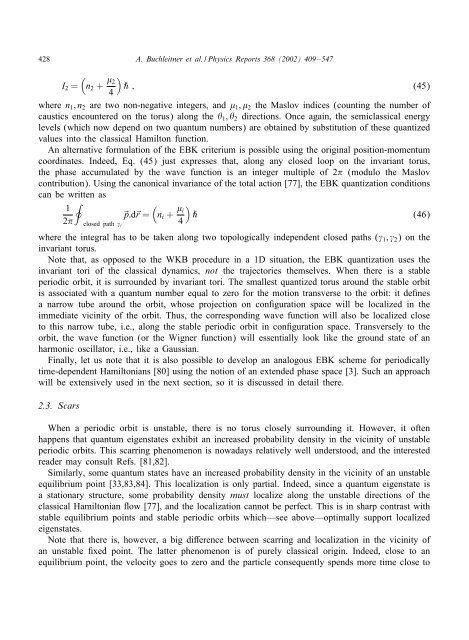Non-dispersive wave packets in periodically driven quantum systems
Non-dispersive wave packets in periodically driven quantum systems
Non-dispersive wave packets in periodically driven quantum systems
Create successful ePaper yourself
Turn your PDF publications into a flip-book with our unique Google optimized e-Paper software.
428 A. Buchleitner et al. / Physics Reports 368 (2002) 409–547<br />
<br />
I2 = n2 + 2<br />
4<br />
<br />
˝ ; (45)<br />
where n1;n2 are two non-negative <strong>in</strong>tegers, and 1; 2 the Maslov <strong>in</strong>dices (count<strong>in</strong>g the number of<br />
caustics encountered on the torus) along the 1; 2 directions. Once aga<strong>in</strong>, the semiclassical energy<br />
levels (which now depend on two <strong>quantum</strong> numbers) are obta<strong>in</strong>ed by substitution of these quantized<br />
values <strong>in</strong>to the classical Hamilton function.<br />
An alternative formulation of the EBK criterium is possible us<strong>in</strong>g the orig<strong>in</strong>al position-momentum<br />
coord<strong>in</strong>ates. Indeed, Eq. (45) just expresses that, along any closed loop on the <strong>in</strong>variant torus,<br />
the phase accumulated by the <strong>wave</strong> function is an <strong>in</strong>teger multiple of 2 (modulo the Maslov<br />
contribution). Us<strong>in</strong>g the canonical <strong>in</strong>variance of the total action [77], the EBK quantization conditions<br />
can be written as<br />
<br />
1<br />
<br />
˜p:d˜r = ni +<br />
2 closed path i<br />
i<br />
<br />
˝ (46)<br />
4<br />
where the <strong>in</strong>tegral has to be taken along two topologically <strong>in</strong>dependent closed paths ( 1; 2) onthe<br />
<strong>in</strong>variant torus.<br />
Note that, as opposed to the WKB procedure <strong>in</strong> a 1D situation, the EBK quantization uses the<br />
<strong>in</strong>variant tori of the classical dynamics, not the trajectories themselves. When there is a stable<br />
periodic orbit, it is surrounded by <strong>in</strong>variant tori. The smallest quantized torus around the stable orbit<br />
is associated with a <strong>quantum</strong> number equal to zero for the motion transverse to the orbit: it de nes<br />
a narrow tube around the orbit, whose projection on con guration space will be localized <strong>in</strong> the<br />
immediate vic<strong>in</strong>ity of the orbit. Thus, the correspond<strong>in</strong>g <strong>wave</strong> function will also be localized close<br />
to this narrow tube, i.e., along the stable periodic orbit <strong>in</strong> con guration space. Transversely to the<br />
orbit, the <strong>wave</strong> function (or the Wigner function) will essentially look like the ground state of an<br />
harmonic oscillator, i.e., like a Gaussian.<br />
F<strong>in</strong>ally, let us note that it is also possible to develop an analogous EBK scheme for <strong>periodically</strong><br />
time-dependent Hamiltonians [80] us<strong>in</strong>g the notion of an extended phase space [3]. Such an approach<br />
will be extensively used <strong>in</strong> the next section, so it is discussed <strong>in</strong> detail there.<br />
2.3. Scars<br />
When a periodic orbit is unstable, there is no torus closely surround<strong>in</strong>g it. However, it often<br />
happens that <strong>quantum</strong> eigenstates exhibit an <strong>in</strong>creased probability density <strong>in</strong> the vic<strong>in</strong>ity of unstable<br />
periodic orbits. This scarr<strong>in</strong>g phenomenon is nowadays relatively well understood, and the <strong>in</strong>terested<br />
reader may consult Refs. [81,82].<br />
Similarly, some <strong>quantum</strong> states have an <strong>in</strong>creased probability density <strong>in</strong> the vic<strong>in</strong>ity of an unstable<br />
equilibrium po<strong>in</strong>t [33,83,84]. This localization is only partial. Indeed, s<strong>in</strong>ce a <strong>quantum</strong> eigenstate is<br />
a stationary structure, some probability density must localize along the unstable directions of the<br />
classical Hamiltonian ow [77], and the localization cannot be perfect. This is <strong>in</strong> sharp contrast with<br />
stable equilibrium po<strong>in</strong>ts and stable periodic orbits which—see above—optimally support localized<br />
eigenstates.<br />
Note that there is, however, a big di erence between scarr<strong>in</strong>g and localization <strong>in</strong> the vic<strong>in</strong>ity of<br />
an unstable xed po<strong>in</strong>t. The latter phenomenon is of purely classical orig<strong>in</strong>. Indeed, close to an<br />
equilibrium po<strong>in</strong>t, the velocity goes to zero and the particle consequently spends more time close to











